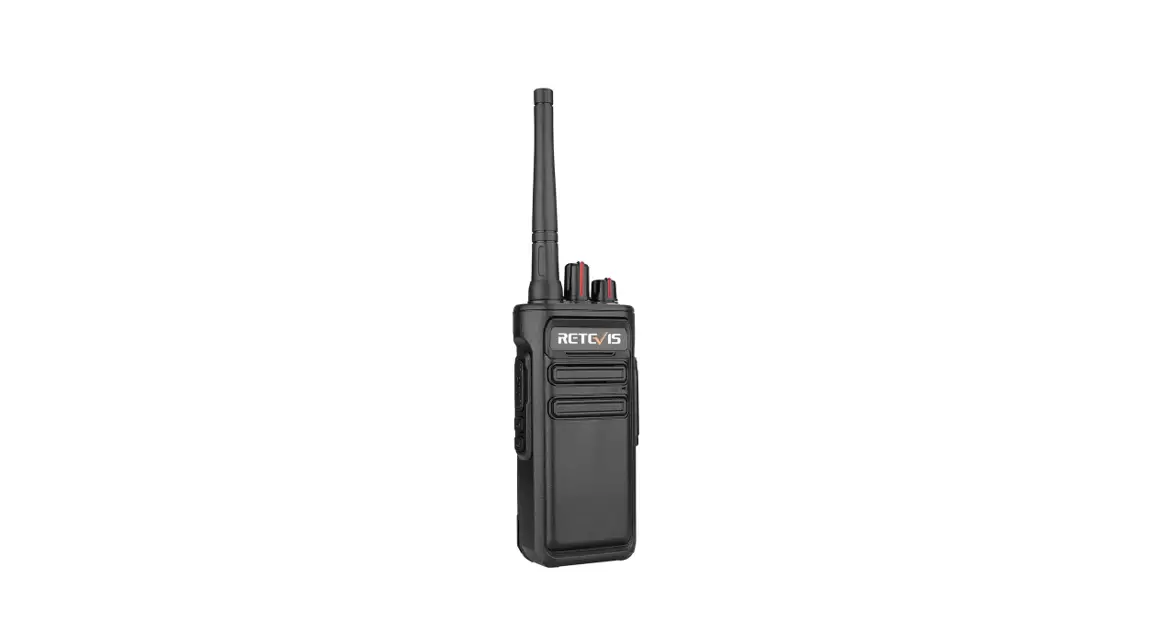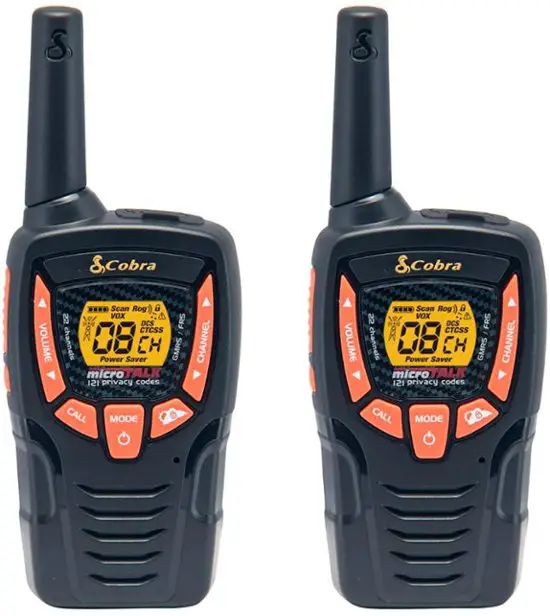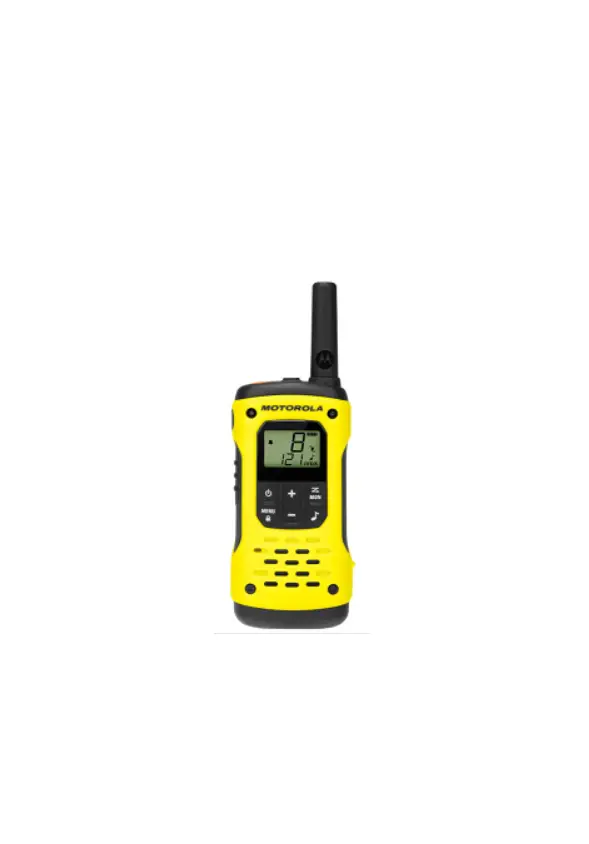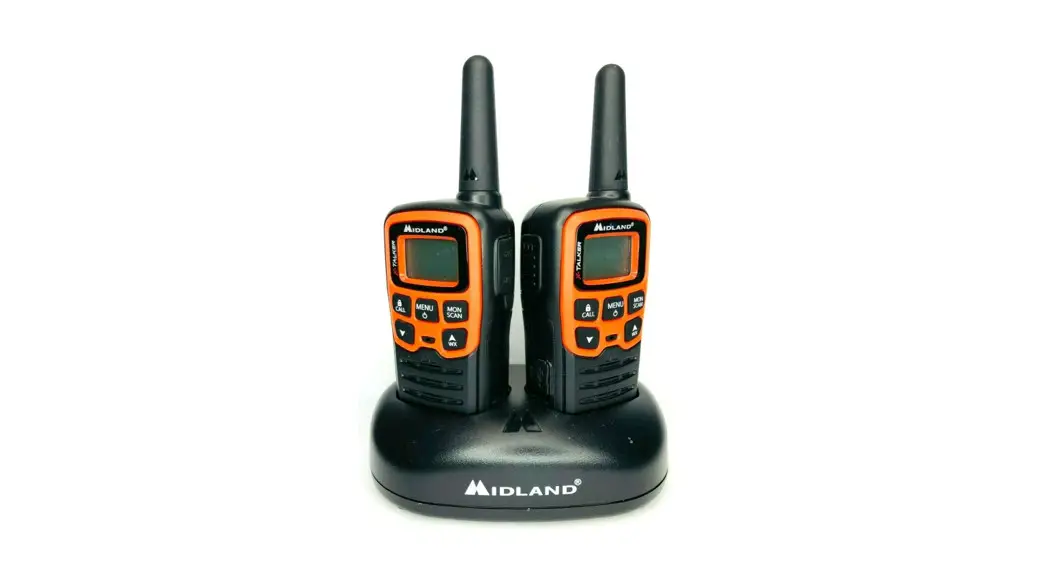
Two Way Radia
RB29

User’s Manual
14x21cm
Warning
Please read this manual carefully before using this radio.
- Please do not communicate or charge this radio in flammable, explosive and area which radio communication is prohibited (such as oil station, gas station, airport etc.)
- Please do not operate this radio without license in government laws banned areas.
- Please make sure this radio avoids the sunshine, and avoids to put it near any heating device.
- Please make sure this radio avoids any dusty, humid and water splashed place, and also avoids to put it near any heating device.
- If radio smells or smokes, please remove the battery pack from radio at once, and then please contact your nearest distributor.
- The repair job of this radio is in the charge of professionals & technical’s, self-disassembly is prohibited.
For downloading further resources: Brochures, Software/Firmware, Manual etc, Pls contact your direct reseller first OR go to website retevis.com and check “support” in the each product link to download it.
EU Importer: Germany Retevis Technology GmbH
Address: Uetzenacker 29,38176 wendeburg
Using tips
Unpacking and Checking the Equipment
- Carefully unpack the radio. We recommend that you confirm the items in the following table before discarding the packing material. If any item is missing or has been damaged during shipment, please contact your first seller.
Accessories list
| Item name | Quantity |
| Battery | 2 |
| Belt Clip | 2 |
| Hand strap | 2 |
| Charger | 2 |
| Screw | 4 |
| User’s Manual | 1 |
Using the battery
The battery is not completely charged at the factory, please charge it before using.
After purchase or extended storage (more than two months), the first time to charge battery cannot make battery reach its normal operating capacity. After repeating charge /discharge it two or three times, the operating capacity will increase to its normal capacity.
Notice: After fully charge the battery, please do not charge it again and should take it off from the charger. If not, it will short or damage the battery life for over charge.
Installing / Removing the Battery
To install the battery into the battery positioning hole of radio bottom, then press the battery, make the button completely to lock battery. To remove the battery, please turn off the radio, and then push up the battery button of radio top, finally take off the battery.


(Install the battery) (Remove the battery)

Installing Earphone /Programming Jack
Uncover earphone lid, directly insert earphones into earphone holes (earphones need to be additionally purchased).
You can use computer programming software to operate (please consult with local dealers about the information of computer programming software).
Note: If your radio developed with VOX function, you should re-turn on radio power once to active VOX function.

Installing the belt clip
If necessary, attach the belt clip to the back of battery with the screws supplied carry conveniently.
Getting Acquainted



- Channel-selecting knob
- Power/volume knob (Power on by rotating clockwise, Power off by rotating counter clockwise till hear the “kata” sound. VOL control by rotating.)
- Microphone
- Speaker
- LED indicator light
(The indicator light turns red when transmit, turns green when receive.) - Antenna
- Moni switch
- PTT switch
- Side-key
(You can customize it in the software) - Speaker/Microphone Jack
- Battery Pack
- Battery release latch
Basic operations
LED indicator
It lights red when transmitting, and lights green when receiving.
Channel-selecting knob
Rotate it to select channel 1-16, clockwise rotation to increase, counter-clockwise rotation to decrease. An alert tone will sound when an empty channel is selected.
Power/Volume knob
Rotate it by clockwise to power on the radio. To turn off the radio, rotate it by counterclockwise until a click sound is heard, VOL control by rotating.
PTT switch
Press PTT switch and then talk to the microphone, the indicator light turns red, if the channel does not have transmitting frequency, a “Du Du” tone sounds, and indicator light turns red. Release PTT switch to receive. It lights green when there is signal.
Side-key
Can be defined in the software as null / VOX/ emergency alarm / scan / busy lock, the default definition is short press scan switch, long press VOX switch.
Moni switch
Press the button to monitor calls with different mute tones at the same frequency, and also press to listen when the signal strength does not reach the opening threshold.
Squelch level
The squelch level will determine the signal strength to open the speaker of the radio. If the squelch level is lower, the background noise of opening the radio’s speaker will be higher, and the corresponding communication range will be further, but the anti-interference ability will be weaker. The default setting of squelch level is 3, you can adjust it through the menu “Squelch level” of the “Optional features” in the software, level 0 to 9 can be selected. 0 is the lowest level.
Time out timer (TOT)
The purpose of TOT is to prevent any radio from talking in one channel for too long, and to prevent the radio from being damaged due to continuous transmission. If the transmitting time exceeds the TOT pre-set time, the radio will stop transmission and an alert tone sounds. Release PTT switch to stop the alert tone, the radio resume to receiving mode.
Scan On/Off
When the radio is set as scan via software, rotate the channel-selecting knob to channel 16, it will start scanning. It will scan all scannable channels from channel 1 to 16. You can define as channel added or deleted in software. When there is signal in the scanning channel, it stops in the channel for talk.
Note:
a. The radio will stay in the channel which has signal, and 15 seconds after the signal disappears, it will continue scanning.
b. It can not scan when there is less than 2 scannable channels.
VOX
Speak to the microphone in normal voice to transmit directly, no need to press PTT switch. Side-key can be defined as VOX switches in the software.
1) When VOX is on in your working channel.
Speak to the microphone directly, it will transmit automatically.
The radio stops transmitting when there is no voice, and waits for receiving.
2) When a headset with a microphone is used.
When VOX is on, you should increase the VOX gain for the radio to identify voice volume.
If microphone is too sensitive, the noise around radio will start transmitting. If microphone is not sensitive, the radio can not collect your voice.
Please adjust VOX level well to guarantee smooth communications.
Note: When turn on VOX and VOX gain is in high and sensitive level, if connect mic/speaker with radio, the signal of mic/speaker will probably cause radio transmit. Whether it is in Chinese or English speech, press and hold the PTT button or VOX are all invalid and issued a “please change battery” voice prompt, and loud “Di” sound until PTT release or end VOX.
Busy channel lockout(BCLO)
If you set busy channel lockout, press PTT after receiving a signal of prohibiting transmit, and issue “Di” sound until PTT release.
QT/DQT
You can select the QT/DQT via program software. When a channel has QT/DQT, the speaker will be turned on when it receives the same QT/DQT. If there is transmitted signal with different QT/DQT in the same channel, the speaker will not open and indicator light turns green
One-Key Frequency Copy
Press the PTT button and the Moni switch on the receiver radio channel 1 at the same time to turn on, the receiver radio will play the voice ” Turn on the Radio-One ” and then the green light will flash slowly, the receiver radio and transmitter radio respectively turn the channel switch to the channel to be stored, the transmitter radio Press PTT to transmit, the green light of the receiver flashes quickly and then the green light flashes slowly after the receiver stops with a beep. After copying is completed, just turn off and restart.![]() : Support different brand walkie talkie copy.
: Support different brand walkie talkie copy.
Frequency Copy all channels at one times
Press the PTT key and the Moni switch on the transmitter and receiver channel 2 at the same time, the transmitter and receiver indicator light green light slowly flash, the transmitter press PTT for 3 seconds and then release, the transmitter indicator light changes from red light to slow flash green light, at the same time, the receiver indicator light changes from fast flash green light to slow flash green light, then the copy is completed, and the computer can be turned off and rebooted.![]() : Only support the same solutions walkie talkie.
: Only support the same solutions walkie talkie.
Trouble shooting guide
| Troubles | Solution |
| No Electrical Source |
|
| The operating time becomes short, even the battery is fully charged. | Replace the battery. |
| Not able to communicate with the transceivers of the same group |
|
| The voice of another group can be heard. | Change all QT/DQT of the group. |
| Other radios can not receive the TX signals or receive signals in a low volume |
|
| Noise is always heard |
|
Specification
| GENERAL | Frequency Range | FRS |
| Rated Voltage | 3.7V DC | |
| Memory Channel | 16 | |
| Frequency Sensitivity | ±0.5ppm | |
| Antenna Impendence | 50Ω | |
| Operation Temperature Range | -30°C~+60°C | |
| TRANSMITTER | RF power | ≤2W |
| Modulation type | 16kΦF3E | |
| Modulation distortion | <5% | |
| Adjacent channel power | ≥65dB | |
| Audio response | +6.5 ~ -14dB | |
| Max FR. Deviation | ≤±5KHz | |
| Spurious Radiation | ≤7.5µW | |
| Current | ≤1200mA | |
| Modulation Noise | <-40dB | |
| Intermediation sensitivity | 8-12mv | |
| RECEIVER | Receiving sensitivity | 0.2µV |
| Adjacent channel selectivity | 65dB | |
| Occupied Bandwidth | ≤16KHz | |
| Current | Standby 55mA, working 150mA | |
| Reference Frequency | 26.000MHz | |
| Inter-modulation | ≥60dB | |
| Spurious | ≥55dB | |
| Audio response | +7~-12.5dB | |
| Audio distortion | <5% | |
| Audio power | 500mW |
Note: Specification will be revised without notice due to technical improvement. Thank you.
CHANNEL AND FREQUENCIES
| Channe | Frequency (MHz) | Max Power Output | CTCSS/DCS |
| 1 | 462.5625 | 2W | 67.0 |
| 2 | 462.5875 | 2W | 118.8 |
| 3 | 462.6125 | 2W | 127.3 |
| 4 | 462.6375 | 2W | 131.8 |
| 5 | 462.6625 | 2W | 136.5 |
| 6 | 462.6250 | 2W | 127.3 |
| 7 | 462.7250 | 2W | 136.5 |
| 8 | 462.6875 | 2W | 141.3 |
| 9 | 462.7125 | 2W | 146.2 |
| 10 | 462.5500 | 2W | 123.0 |
| 11 | 462.5750 | 2W | D743I |
| 12 | 462.6000 | 2W | D332I |
| 13 | 462.6500 | 2W | D243I |
| 14 | 462.6750 | 2W | D606N |
| 15 | 462.7000 | 2W | D731I |
| 16 | 462.7250 | 2W | D462I |
RF ENERGY EXPOSURE AND PRODUCT SAFETY GUIDE FOR PORTABLE TWO-WAY RADIOS
 ATTENTION! ATTENTION! | Before using this radio, read this guide which contains important operating instructions for safe usage and RF energy awareness and control for compliance with applicable standards and regulations. |
This two-way radio uses electromagnetic energy in the radio frequency (RF) spectrum to provide communications between two or more users over a distance. RF energy, which when used improperly, can cause biological damage.
All Retevis two-way radios are designed, manufactured, and tested to ensure they meet government-established RF exposure levels. In addition, manufacturers also recommend specific operating instructions to users of two-way radios. These instructions are important because they inform users about RF energy exposure and provide simple procedures on how to control it.
Please refer to the following websites for more information on what RF energy exposure is and how to control your exposure to assure compliance with established RF exposure limits: http://www.who.int/en/
Local Government Regulations
When two-way radios are used as a consequence of employment, the Local Government Regulations requires users to be fully aware of and able to control their exposure to meet occupational requirements. Exposure awareness can be facilitated by the use of a product label directing users to specific user awareness information. Your Retevis two-way radio has a RF Exposure Product Label. Also, your Retevis user manual, or separate safety booklet includes information and operating instructions required to control your RF exposure and to satisfy compliance requirements.
Radio License
Governments keep the radios in classification, business two-way radios operate on radio frequencies that are regulated by the local radio management departments (FCC, ISED, OFCOM, ANFR, BFTK, Bundesnetzagentur.. ).To transmit on these frequencies, you are required to have a license issued by them. The detailed classification and the use of your two radios, please contact the local government radio management departments.
Use of this radio outside the country where it was intended to be distributed is subject to government regulations and may be prohibited.
Changes or modifications not expressly approved by the party responsible for compliance may void the user’s authority granted by the local government radio management departments to operate this radio and should not be made. To comply with the corresponding requirements, transmitter adjustments should be made only by or under the supervision of a person certified as technically qualified to perform transmitter maintenance and repairs in the private land mobile and fixed services as certified by an organization representative of the user of those services.
Replacement of any transmitter component (crystal, semiconductor, etc.) not authorized by the local government radio management departments equipment authorization for this radio could violate the rules.
FCC Requirements:
This device complies with part 15 of the FCC Rules. Operation is subject to the condition that this device does not cause harmful interference. (Licensed radios are applicable);
This device complies with part 15 of the FCC Rules. Operation is subject to the following two conditions: (Other devices are applicable)
(1) This device may not cause harmful interference, and
(2) this device must accept any interference received, including interference that may cause undesired operation.
NOTE: This equipment has been tested and found to comply with the limits for a Class A digital device, pursuant to part 15 of the FCC Rules. These limits are designed to provide reasonable protection against harmful interference when the equipment is operated in a commercial environment. This equipment generates, uses, and can radiate radio frequency energy and, if not installed and used in accordance with the instruction manual, may cause harmful interference to radio communications. Operation of this equipment in a residential area is likely to cause harmful interference in which case the user will be required to correct the interference at his own expense.
CE Requirements:
- (Simple EU declaration of conformity) Shenzhen Retevis Technology Co., Ltd. declares that the radio equipment type is in compliance with the essential requirements and other relevant provisions of RED Directive 2014/53/EU and the ROHS Directive 2011/65/EU and the WEEE Directive 2012/19/EU; the full text of the EU declaration of conformity is available at the following internet address: www.retevis.com.
- Restriction Information
This product can be used in EU countries and regions, including: Belgium (BE), Bulgaria (BG), Czech Republic (CZ), Denmark (DK), Germany (DE), Estonia (EE), Ireland (IE), Greece (EL), Spain (ES), France (FR), Croatia (HR), Italy (IT), Cyprus (CY), Latvia (LV), Lithuania (LT), Luxembourg (LU), Hungary (HU), Malta (MT), Netherlands (NL), Austria (AT), Poland (PL), Portugal (PT), Romania (RO), Slovenia (SI), Slovakia (SK), Finland (FI), Sweden (SE) and United Kingdom (UK).
For the warning information of the frequency restriction, please refer to the package or manual section.

- Disposal
The crossed-out wheeled-bin symbol on your product, literature, or packaging reminds you that in the European Union, all electrical and electronic products, batteries, and accumulators (rechargeable batteries) must be taken to designated collection locations at the end of their working life. Do not dispose of these products as unsorted municipal waste. Dispose of them according to the laws in your area.
IC Requirements:
Licence-exempt radio apparatus
This device contains licence-exempt transmitter(s)/receiver(s) that comply with Innovation, Science and Economic Development Canada’s licence-exempt RSS(s). Operation is subject to the following two conditions:
(1) This device may not cause interference.
(2) This device must accept any interference, including interference that may cause undesired operation of the device.
RF Exposure Information
- DO NOT operate the radio without a proper antenna attached, as this may damage the radio and may also cause you to exceed RF exposure limits. A proper antenna is the antenna supplied with this radio by the manufacturer or an antenna specifically authorized by the manufacturer for use with this radio, and the antenna gain shall not exceed the specified gain by the manufacturer declared.
- DO NOT transmit for more than 50% of total radio use time, more than 50% of the time can cause RF exposure compliance requirements to be exceeded.
- During transmissions, your radio generates RF energy that can possibly cause interference with other devices or systems. To avoid such interference, turn off the radio in areas where signs are posted to do so.
- DO NOT operate the transmitter in areas that are sensitive to electromagnetic radiation such as hospitals, aircraft, and blasting sites.
- Portable Device, this transmitter may operate with the antenna(s) documented in this filing in Push-to-Talk and body-worn configurations. RF exposure compliance is limited to the specific belt-clip and accessory configurations as documented in this filing and the separation distance between user and the device or its antenna shall be at least 2.5 cm.
- Mobile Device, during operation, the separation distance between user and the antenna subjects to actual regulations, this separation distance will ensure that there is sufficient distance from a properly installed externally-mounted antenna to satisfy the RF exposure requirements.
- Occupational/Controlled Radio, this radio is designed for and classified as “Occupational / Controlled Use Only”, meaning it must be used only during the course of employment by individuals aware of the hazards, and the ways to minimize such hazards; NOT intended for use in a General population/uncontrolled environment.
- General population/uncontrolled Radio, this radio is designed for and classified as “General population/uncontrolled Use”.
RF Exposure Compliance and Control Guidelines and Operating Instructions
To control your exposure and ensure compliance with the occupational/controlled environment exposure limits, always adhere to the following procedures.
Guidelines:
- User awareness instructions should accompany the device when transferred to other users.
- Do not use this device if the operational requirements described herein are not met.
Operating Instructions:
- Transmit no more than the rated duty factor of 50% of the time. To Transmit (Talk), push the Push to Talk (PTT) button. To receive calls (listen), release the PTT button. Transmitting 50% of the time, or less, is important because the radio generates measurable RF energy exposure only when transmitting in terms of measuring for standards compliance.
- Transmit only when people outside the vehicle are at least the recommended minimum lateral distance away from a properly installed according to installation instructions, externally mounted antenna.
- When operating in front of the face, worn on the body, always place the radio in a Retevis approved clip, holder, holster, case, or body harness for this product. Using approved body-worn accessories is important because the use of Non-Retevis approved accessories may result in exposure levels, which exceed the IEEE/ICNIRP RF exposure limits.
Hand-held Mode

- Hold the radio in a vertical position with the microphone (and other parts of the radio including the antenna) at least 2.5 cm (one inch) away from the nose or lips. The antenna should be kept away from the eyes. Keeping the radio at a proper distance is important as RF exposure decreases with increasing distance from the antenna.
Phone Mode
- When placing or receiving a phone call, hold your radio product as you would a wireless telephone. Speak directly into the microphone.
Electromagnetic Interference/Compatibility
NOTE: Nearly every electronic device is susceptible to electromagnetic interference (EMI) if inadequately shielded, designed, or otherwise configured for electromagnetic compatibility.
Avoid Choking Hazard

Turn off your radio power in the following conditions:

- Turn off your radio before removing (installing) a battery or accessory or when charging battery.
- Turn off your radio when you are in a potentially hazardous environments: Near electrical blasting caps, in a blasting area, in explosive atmospheres (inflammable gas, dust particles, metallic powders, grain powders, etc.).
- Turn off your radio while taking on fuel or while parked at gasoline service stations.
To avoid electromagnetic interference and/or compatibility conflicts - Turn off your radio in any facility where posted notices instruct you to do so, hospitals or health care facilities (Pacemakers, Hearing Aids and Other Medical Devices) may be using equipment that is sensitive to external RF energy.
- Turn off your radio when on board an aircraft. Any use of a radio must be in accordance with applicable regulations per airline crew instructions.
Protect your hearing:

- Use the lowest volume necessary to do your job.
- Turn up the volume only if you are in noisy surroundings.
- Turn down the volume before adding headset or earpiece.
- Limit the amount of time you use headsets or earpieces at high volume.
- When using the radio without a headset or earpiece, do not place the radio’s speaker directly against your ear
- Use careful with the earphone maybe possible excessive sound pressure from earphones and headphones can cause hearing loss

Note: Exposure to loud noises from any source for extended periods of time may temporarily or permanently affect your hearing. The louder the radio’s volume, the less time is required before your hearing could be affected. Hearing damage from loud noise is sometimes undetectable at first and can have a cumulative effect.
Avoid Burns

Antennas
- Do not use any portable radio that has a damaged antenna. If a damaged antenna comes into contact with the skin when the radio is in use, a minor burn can result.
Batteries (If appropriate)
- When the conductive material such as jewelry, keys or chains touch exposed terminals of the batteries, may complete an electrical circuit (short circuit the battery) and become hot to cause bodily injury such as burns. Exercise care in handling any battery, particularly when placing it inside a pocket, purse or other container with metal objects
Long transmission
- When the transceiver is used for long transmissions, the radiator and chassis will become hot.
Safety Operation

Forbid
- Do not use charger outdoors or in moist environments, use only in dry locations/conditions.
- Do not disassemble the charger, that may result in risk of electrical shock or fire.
- Do not operate the charger if it has been broken or damaged in any way.
- Do not place a portable radio in the area over an air bag or in the air bag deployment area. The radio may be propelled with great force and cause serious injury to occupants of the vehicle when the air bag inflates.
To reduce risk
- Pull by the plug rather than the cord when disconnecting the charger.
- Unplug the charger from the AC outlet before attempting any maintenance or cleaning.
- Contact Retevis for assistance regarding repairs and service.
- The adapter shall be installed near the equipment and shall be easily accessible
Approved Accessories

- This radio meets the RF exposure guidelines when used with the Retevis accessories supplied or designated for the product. Use of other accessories may not ensure compliance with the RF exposure guidelines and may violate regulations.
- For a list of Retevis-approved accessories for your radio model, visit the following website: http://www.Retevis.com
Guarantee
Model Number: __________________________________
Serial Number: ___________________________________
Purchasing Date: __________________________________
Dealer: ____________________ Telephone: ____________
User’s Name: _______________ Telephone: ____________
Country: ____________________ Address: _____________
Post Code: __________________ Email: _______________
Remarks:
- This guarantee card should be kept by the user, no replacement if lost.
- Most new products carry a two-year manufacturer’s warranty from the date of purchase.
Further details, pls read http://www.retevis.com/after-sale/ - The user can get warranty and after-sales service as below:
• Contact the seller where you buy.
• Products Repaired by Our Local Repair Center - For warranty service, you will need to provide a receipt proof of purchase from the actual seller for verification
Exclusions from Warranty Coverage:
- To any product damaged by accident.
- In the event of misuse or abuse of the product or as a result of unauthorized alterations or repairs.
- If the serial number has been altered, defaced, or removed.

Shenzhen Retevis Technology Co.,Ltd.
Room 700, 7/F, 13-C, Zhonghaixin Science&Technology Park,
No.12 Ganli 6th Road, Jihua Street, Longgang District,
Shenzhen, China
Web: www.retevis.com
E-mail: [email protected]
Facebook: facebook.com/retevis




MADE IN CHINA
Documents / Resources
 | RETEVIS RB29 Walkie Talkie Two Way Radio [pdf] User Manual RB29, 2ASNSRB29, RB29 Walkie Talkie Two Way Radio, Walkie Talkie Two Way Radio |






